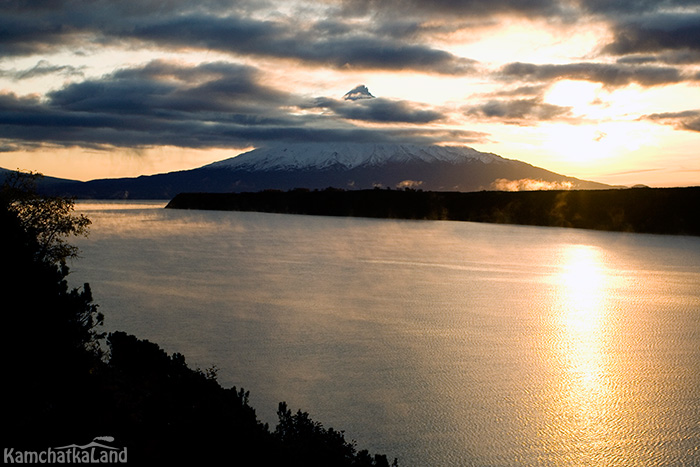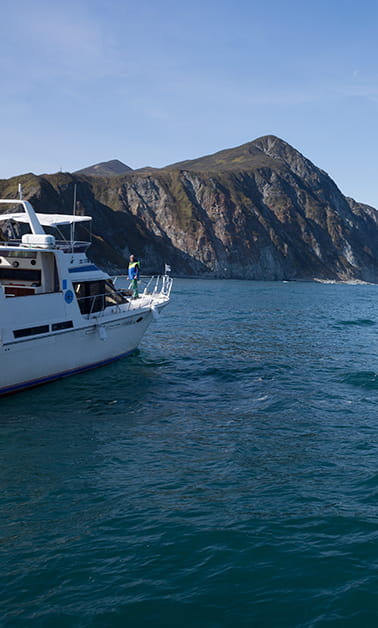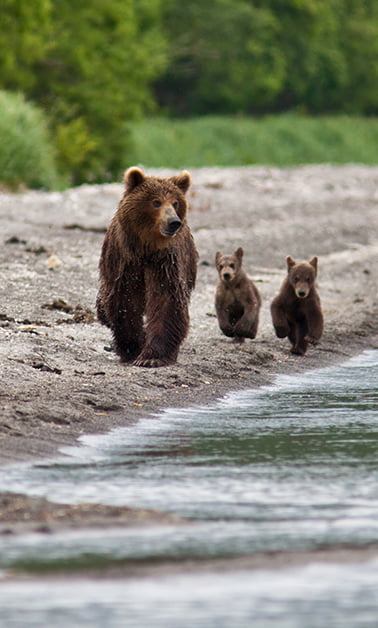
Kronotskoye Lake
Kronotsky Lake is one of the largest lakes in Kamchatka. It has its own specific closed ecosystem, which is home to rare species of animals, birds and fish.
Kronotskoye lake is a beauty nature monument of the Kamchatka peninsula. This is one of the largest lakes situating on the area of Kronotsky Nature Reserve in Elizovo region near the famous Valley of Geysers.

Description
The coordinates of the lake is the following: 54.800762°N 160.22982°E
The surface area is 245 km2 , and catchment basin is 2330 km2. This is the second largest and the deepest of fresh lakes in Kamchatka. Maximum deep reaches 150 meters in according to the new dates. The water becomes fully frozen during the period from December to May. The thickness of ice reaches 1 meter at some places.

There are the famous sopka (volcanoes) located from the east and the south, such as Kronotsky sopka with a right cone shape, as well as a massive small volcano named Krasheninnikov. Schmidt mountain is located on the opposite side. As well, a few rivers flow into the lake, such as: the Uzon, the Unana, the Severnaya, the Listvennichnaya and the other. The Kronotskaya river is the only river which flows out of the Kronotskoye.
Kronotskoye lake is imaged on the map of the Kamchatka peninsula like a shape of isosceles triangle. The reason is that it is surrounded by the mountain ranges and chains of 16 volcanoes.
History of discovery. Origin of hollow.
The earliest references to the lake date back to the stories of locals which then were written by Stephan Petrovich Krasheninnikov. Soboliny Sanctuary was established there in order to protect sable from their extermination. The first expedition was leaded by Peter Yurievich Schmidt, and it was hold in 1908. He visited the northern and the eastern banks of the waterbody, as well as he described the area of upstream of the Kronotsky river. Another results of this expedition are the creation of topography map imaging shape and forms of the lake.
It`s name is rooted in the time of Itelmens. The name of the Kronotskoye is a result of combination of two Itelmen words, such as “Kranak”,“Kranvan” meaning “highland” and “Uach” meaning “Stone”. Thus, the ancient name was “Kranakuach”. “Kranakoch” “kranakots” which means “High stone mountain” or “Highland lake”.

Kronotskoye is referred to barrier lake hollow (waterbody). The origin is a result of damning the riverbed by lava flows after the eruptions of Kornotsky and Krasheninnikov volcanoes which happened about 10 000 years ago. It was long believed that the lake had caldera origin. However, Evgeny Krokhin proved that the lake has the volcanic origin in accordance to his analysis basin which was investigated in the 20th year of XX centaury. The lake is fed by rain and snow. Today the height of the water surface reaches 372 meters above sea level.
The most interesting fact is the eruption of Kizimen volcano in 2009, after which the water temperature increased for 8°С and thus reached 13°С.

Flora and fauna of Kronotskoye Lake
The unique of Kronotskoye lake is not only because it has an unusual origin but also it has unique nature complex. The population of kokanee (red salmon) was formed for the entire period of its development. By last count, there are about 30 million kokanee species. Thanks to long-term isolation of the specimen of sea world, the group of loach was also formed there. All specimen of the lake ecosystem is constantly monitored by geneticists and ichthyologists.
The eastern shore of the lake is surrounded with 11 small islands. They have names in the honor of the members of Kamchatka expedition, which was leaded by Fedor Ryabushinsky, such as: Komarov island, Bar island, Kanradi island and the others.

The colonies of the loud Pacific gulls nest in the place situated about 40 away the lakeshore. The total number of these birds reaches about 600 species. Such gathering of birds located on such a large distance from sea shores is also observed at the area of Kurile and Azhabachye lakes.
The Kronotskaya river flows out of the lake. The stream has powerful rapids along the distance of 12 kilometers, so that it prevents salmon spawning there. However, despite these hard conditions ichthyologists observes that the number of bull trout is increasing near the river source. Brown bears visit rarely this place because of the small quantity of fish.

The tract of Kamchatka larch plays important role in the nature complex, and where there is rare Jezo spruce. The forest area reaches 4000 hectares. Osprey, Stellers sea eagles, Peregrines, and sometimes Gyrfalcons and Golden eagles nests among the larch trees.
The most graceful and beautiful inhabitants of local fauna is swan. There are only two places which are chosen for nesting. However, during autumn many pride swans stay for winter there. In summer they are enough careful and suspicious of people but in winter they are usually used to live near people and don`t afraid of them.

Information for photograph
Kronotskoye lake will be one of the most peaceful and photogenic places of Kamchatka peninsula for a photographer. Because of changeable weather you will be able to see all weather changes on the territory of the Reserve: clear sky, cumulus and tight clouds, fast flow of air mass, rain, wind, storm, as well as sun. Kronotskaya sopka which is perfectly visible from any points, and it is famous for the frequent visits by lenticular clouds looking like cotton candy.
Information for tourists: days-long tour, hike, as well one-day excursions
There are no special tourist routes to Kronotskoye. As a rule, a visit is possible during an excursion to the Valley of Geysers and the caldera of Uzon volcano which are organized by our tour operator. Independent hike to the lake is prohibited even if you know how to reach the lake and where it locates. There are no prepared routes, except for using a boat. The worker of the Nature Reserve and inspectors have a possibility to arrange a boat trip around the lake. However, it is better to create such itinerary in advance while purchasing a tour.

The Airfield cordon is the most popular place thanks to Igor Shpilenk`s memoirs. A lot of habitants live there which were described in his diary.
There is another interesting option for those who love to live in wildness that is a work as a volunteer in the Reserve. However, be careful, there are no “kind” bears! There are not so many brown bears but anyway it is more dangerous to meet them than on Lake Kuril. Going out alone of the camp and without having a hand flare is strictly prohibited in accordance with the rules of the Reserve.
Popular tours with Kamchatkaland
Ready-made packages for your travel and vacation in Kamchatka






